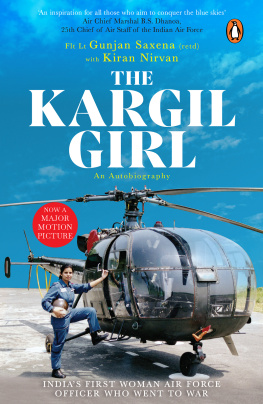V N Thapar - Vijyant at Kargil
Here you can read online V N Thapar - Vijyant at Kargil full text of the book (entire story) in english for free. Download pdf and epub, get meaning, cover and reviews about this ebook. year: 2020, publisher: Penguin Random House India Private Limited, genre: Non-fiction. Description of the work, (preface) as well as reviews are available. Best literature library LitArk.com created for fans of good reading and offers a wide selection of genres:
Romance novel
Science fiction
Adventure
Detective
Science
History
Home and family
Prose
Art
Politics
Computer
Non-fiction
Religion
Business
Children
Humor
Choose a favorite category and find really read worthwhile books. Enjoy immersion in the world of imagination, feel the emotions of the characters or learn something new for yourself, make an fascinating discovery.

- Book:Vijyant at Kargil
- Author:
- Publisher:Penguin Random House India Private Limited
- Genre:
- Year:2020
- Rating:3 / 5
- Favourites:Add to favourites
- Your mark:
- 60
- 1
- 2
- 3
- 4
- 5
Vijyant at Kargil: summary, description and annotation
We offer to read an annotation, description, summary or preface (depends on what the author of the book "Vijyant at Kargil" wrote himself). If you haven't found the necessary information about the book — write in the comments, we will try to find it.
Vijyant at Kargil — read online for free the complete book (whole text) full work
Below is the text of the book, divided by pages. System saving the place of the last page read, allows you to conveniently read the book "Vijyant at Kargil" online for free, without having to search again every time where you left off. Put a bookmark, and you can go to the page where you finished reading at any time.
Font size:
Interval:
Bookmark:


NEHA DWIVEDI

PENGUIN BOOKS

PENGUIN BOOKS
EBURY PRESS
COL V. N. THAPAR is the father of Capt Vijyant Thapar, Vir Chakra, who was a fourth-generation army officer. At the age of fifteen, he was selected for the National Defence Academy and commissioned on 12 December 1962 in the Maratha Light Infantry. He commanded a battalion of the Jammu and Kashmir Rifles. He was part of the 1965 Indo-Pakistan war and the 1971 Bangladesh Liberation war, and has operated in counter-insurgency operations. He is an alumnus of the prestigious Defence Services Staff College, Wellington. He has written for many publications and been a motivational speaker at various forums, universities, colleges and schools.
NEHA DWIVEDI, a Kargil war martyrs daughter and an Armoured Corps officers wife, is a doctor by profession. She is an alumnus of Delhi Public School R.K. Puram and Lady Hardinge Medical College, Delhi. She sought solace and found her strength in writing post her fathers martyrdom. She now lives in Mumbai, where she works as a childbirth educator and an infant and young child feeding specialist. She deeply believes in the healing and inspirational power of stories. This is her first book.
To the fighting spirit of the Indian Army.
To Tripta, a mother, who, like many other army mothers, bore the pain of her loss with quiet dignity, courage and fortitude, and to the nation, which came as one to support us in the time of crisis.
And to Vijender, Roli, Vasundhara, the coming generation who will uphold the torch.
To you who are the sons and brothers of the departed, I see that the struggle to emulate them will be an arduous onePericles (Peloponnesian War, Athens)
I t is a privilege to write a foreword to a book that celebrates the life of Capt Vijyant Thapar, Vir Chakra (VrC), who, at the young age of twenty-two, became a national icona symbol of exceptional bravery, dedication, patriotism and young military leadership.
Written by his father, Col Virender Nath Thapar (Retired), and Neha Dwivedi, who would have been assisted by Vijyants mother, Mrs Tripta Thapar, and other members of the family and friends, this narrative cannot be more factual or authentic.
This book takes you through Vijyant Thapars life and introduces you to his family, school and college friends, the Indian Military Academy (IMA) and, finally, his renowned unit, 2nd Battalion, the Rajputana Rifles.
Vijyant was not an academic topper in school or college. His heart lay elsewhere, mostly outdoors. He imbibed the high qualities required of a military leader through the sanskar (values) handed down to him by four generations of army officers in the family, training in the National Cadet Corps and the IMA, and the cantonment environment. The IMA is the fountainhead of military valuessmartness, discipline, dignity, a strong sense of morality and integrity. Most important is its credo:
The safety, honour and welfare of your country come first, always and every time. The honour, welfare and comfort of the men you command come next. Your own ease, comfort and safety come last, always and every time.
He honed his qualities of camaraderie, compassion, military traditions and honour during his short-lived tenure in his battalion.
After reading Vijyants letter addressed to Dearest Papa, Mamma, Birdie and Granny many years ago, I had wondered about his thoughts and feelings when he wrote it. This letter is proof of his love for his kin, for the Indian Army and the nation. Hidden behind the casual, carefree call of a young man (my clan of the Dirty Dozen... live life king size), there was a deep sense of compassion, regimental spirit, determination and extraordinary devotion to duty. He wanted his family to be proud of and never forget the sacrifice of his men. His concern for the little girl Ruksana in Kashmir, even though he was staring death in the face, spoke volumes about his evolved and noble soul.
How did a person of such a young age think of all this when he knew he was leading his team into close combat, where he would face the ultimate danger to his own life and that of his colleagues? This book has come as an explanation to all these thoughts of mine. Quite obviously, real courage lies in moving forward despite the presence of fear. Responsible leadership sublimates the fear of the unknown. During the historic Battle of Tololing on the night of 1213 June, he displayed this during the attack on Barbad Bunker, in which he led the assault with his platoon of A Company.
During the Kargil war, on 28 June 1999, I happened to visit the Tactical Headquarters of 8 Mountain Division, located near Drass. The general officer commanding (GOC), Maj Gen (later Lt Gen) Mohinder Puri, briefed me about the progress made by his troops in the Drass sector. He mentioned that a battalion of 56 Mountain Brigade would be assaulting Knoll and then capture the Three Pimples area early next morning. The task to capture Three Pimples had been given to the same battalion that had broken the stalemate at Tololing and given us the first battle victory2nd Battalion, the Rajputana Rifles.
From our location, I could see the Three Pimples area clearly. It was a cluster of very sharp, craggy and imposing mountaintops. I could imagine the challenges the soldiers would face to get to and assault this feature. The time was around 3.30 p.m. On an impulse, to encourage the battalion and to wish it good luck, I asked Mohinder Puri if I could be connected on telephone to Lt Col (later Col) M.B. Ravindranath, the commanding officer of 2 Rajputana Rifles. Ravindranath, along with his small party, was then located near the forming-up location for the assault. He was taken aback when he learnt about the telephone call from the army chief. He spoke to me in whispers, probably due to his close proximity to the enemy. I inquired about the battalion and wished him and his men good luck in their mission. This must have been a rare occasion in military history when an army chief spoke to a battalion commander just when the latter was close to a forming-up place in a battle.
The next morning, in the Military Operations Room of the Army Headquarters, I was informed that the Three Pimples area had been recaptured. Our soldiers had fought gallantly. But the battalion had suffered heavy casualtiesthree officers, including Capt Vijyant Thapar, and eight soldiers had been martyred while fifty-two other soldiers had been wounded.
That was one of my saddest days of the war. The battle of Knoll and Three Pimples was one of the toughest-fought by the Indian Army in the Kargil war. A detailed account and the role and conduct of Vijyant in this battle have been given by the author. For his exceptional act of personal bravery and leadership, Vijyant was posthumously awarded the Vir Chakra.
While the book remains focused on Vijyant, many serving soldiers and veterans (like me) will find it nostalgic too.
Before signing off, I wish to pay my respects to the Thapar family. Ever since the Kargil war, despite the loss of their elder son, both Virender and Tripta have shown tremendous courage and forbearance. They have addressed and inspired the youth of our nation whenever given such an opportunity. Vijyant, in his letter, had expressed a wish, Please come and see where the Indian Army fought for your tomorrow. Year after year, Virender has been visiting Drass and, till recently, climbing up to the spot where his son was martyred.
Font size:
Interval:
Bookmark:
Similar books «Vijyant at Kargil»
Look at similar books to Vijyant at Kargil. We have selected literature similar in name and meaning in the hope of providing readers with more options to find new, interesting, not yet read works.
Discussion, reviews of the book Vijyant at Kargil and just readers' own opinions. Leave your comments, write what you think about the work, its meaning or the main characters. Specify what exactly you liked and what you didn't like, and why you think so.










